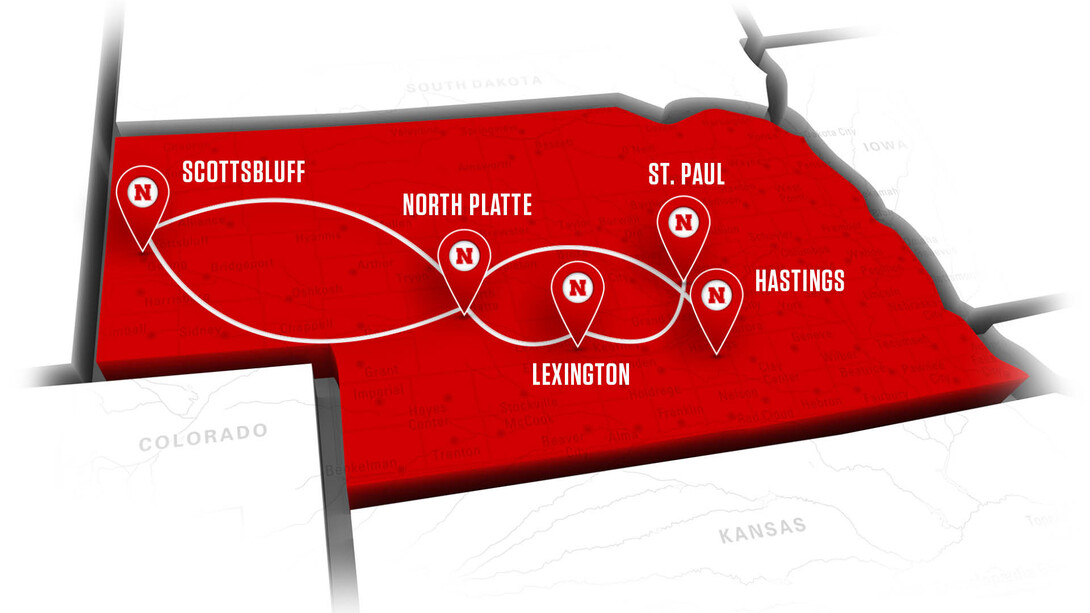
Chancellor Ronnie Green traveled 900 miles visiting communities across Nebraska March 14-16, answering questions about the University of Nebraska-Lincoln and asking for support as the institution pursues its goals amidst short-term budget challenges.
“It was immensely positive,” Green said of the trip. “There’s tremendous belief in and support for the university. Over and over I heard the message ‘Don’t let short-term problems overshadow your long-term goals.’”
The Nebraska Alumni Association helped arrange receptions for Green in Hastings on March 14, Scottsbluff and North Platte on March 15 and St. Paul on March 16. He also made stops along the way to visit with press at the North Platte Telegraph, Scottsbluff Star-Herald and KRVN radio in Lexington. Green attended similar receptions for alumni on March 6 in Lincoln and March 7 in Omaha.
It wasn’t the first, or even the most extensive, statewide tour Green has made since being named chancellor nearly two years ago. He took two such trips in 2017, one in August to visit state lawmakers in their home communities and one in January and February to introduce new appointees Donde Plowman and Mike Boehm to people across the state. Plowman became executive vice chancellor and chief academic officer and Boehm became Harlan Vice Chancellor of the Institute of Agriculture and Natural Resources on Jan. 1, 2017.
“It’s one of my favorite parts of my job,” Green said. “It is always a privilege to talk about the significant impact of the university and its six-to-one return on investment, especially to alumni and stakeholders across the great state of Nebraska.”
This trip was somewhat different, however, because it was scheduled in March, and at the same time the Nebraska Legislature is scheduled to take up debate on a proposed budget that could significantly reduce university funding.
“I’m going out there to connect with people over the short-term challenges the university faces and to gain their support with the budget,” he said. “But there’s certainly much more to the message — I want to remind them of the exciting things happening in their own backyard, at their university, including several consecutive years of all-time enrollment and research records. They know we have world-leading programs at UNL in water and food security and in early childhood development and education — but do they know that our high-energy physics program is working to understand matter at the most fundamental level and our extreme light laser team is innovating to help combat weapons of mass destruction? Do they know we have national recognized programs in creative writing, in actuarial science, in emerging media and software engineering or in digital humanities research? I can just go down a long list of world-class research and creative activity that is changing the world — all happening here at Nebraska, across all nine of our academic colleges — and being extended to the citizenry of Nebraska through one of the nation’s leading extension outreach programs in Nebraska Extension.”
Green also asked attendees to understand the realities of the university’s finances. State appropriations amount to about 20 percent of a $1.3 billion total budget at the University of Nebraska-Lincoln — but it is the critical part that pays for faculty, staff and programs. Housing and dining are financed through the revenues they generate. Grant dollars and donors support research centers and major research initiatives. Athletics, too, is self-supported through the revenues its programs generate.
“We can’t solve our budget problems through athletics or from dining halls or even from foundation dollars,” Green said. “Yet we recognize the dilemmas state government faces, with low ag commodity prices and the press for tax relief.”
Attendees and media asked him questions that revealed their commitment to their communities, he said. They asked how many students in their area might be prevented from going to college if the university raises tuition. They asked how budget cuts might influence university programs and facilities in their region. They asked if the university could do more to recruit students from Nebraska.
Green said he discussed the university’s efforts to recruit and retain students to successful completion of their degrees, including the nearly 25 percent of students who are the first in their families to attend college. He stressed the power of accessible public higher education.
“When we make higher education more private, by reducing public funding, we take away access,” he said. “Public higher education is an investment in the future of Nebraska, not a cost.”







